Daily News
by Gail Helmer
[ Send Us News | Archives ]
Delta Force: Land Warrior Patch v1.00.42
NovaLogic has issued new patches for Delta Force: Land Warrior, updating their older tactical first-person shooter to version 1.00.42. This is a "maintenance release incorporating fixes to various cheats". Download
Ultimate Gamers Expo Announced
A new gaming expo has been announced that is open to the public and not restricted by age, unlike the industries biggest gaming event of the year, E3 (Electronic Entertainment Expo). The new three-day show, the Ultimate Gamers Expo, will run from August 15 through 17, 2003, in the Los Angeles Convention Center's south hall.
The purpose of the UGE is to allow "gamers of all ages to test-drive the latest games and platforms, participate in tournaments, attend game design workshops, and enjoy live entertainment." The UGE is running at the same time as the X-Games, which will take place adjacent to the convention center. More details are available on the UGE Website
Codemasters Offers Career Guides
Codemasters is now offering a series of free career guides on its website, designed to help people maneuver through the first steps to a position in the game industry. Tips are currently offered on obtaining jobs in the graphics, programming and quality assurance (QA) fields. Codemasters launched the service in response to the "thousands" of letters and emails the company has received from students, who ask for advice on the courses they should take, and the qualifications needed, to break into the game business.
Military News
USS Paul Hamilton Collides with Vessel in Arabian Gulf
USS Paul Hamilton (DDG 60) collided with an unidentified vessel while conducting maritime operations in the North Arabian Gulf Dec. 6. No personnel were injured aboard Paul Hamilton. The ship suffered a hole in its side above the waterline but is still able to continue its mission. The cause of the incident is under investigation.
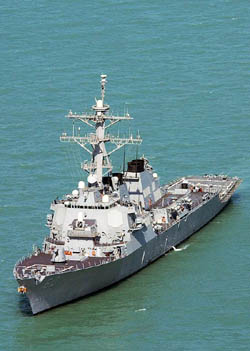
Paul Hamilton is part of the USS Abraham Lincoln (CVN 72) battle group, which is deployed for its regularly scheduled six-month deployment on station in support of Operation Enduring Freedom.
Paul Hamilton is an Arleigh Burke-class destroyer and is designed to help safeguard larger ships in the battle group. Its role is to primarily to perform strike, anti-air, anti-submarine and anti-surface warfare duty.
Air Force boss to Grill F/A-22 execs
Lockheed Martin managers are likely to face tough questions today from Air Force Secretary James Roche about continuing delays and new cost overruns in the F/A-22 fighter program.
The stealthy, supersonic jets being built in Marietta are the centerpiece of the Air Force's future strategy, and Roche has staked his career on getting the cutting-edge planes into the U.S. arsenal.
But Roche and other Bush administration and Pentagon officials were bitterly disappointed last month when they learned of a $690 million overrun in F/A-22 development costs.
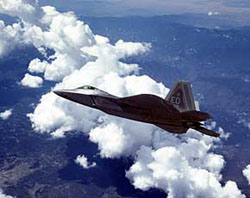
They reacted by firing the top two Air Force generals in charge of the program and insisted Lockheed replace its top F/A-22 executive in Marietta. The turmoil ended two years of relative peace for the program, which narrowly survived a congressional revolt in 1999.
Today, Roche is coming to Marietta for face-to-face meetings with top Lockheed managers, and observers say the conversations probably won't be pleasant.
"Roche isn't happy, and Lockheed's senior managers are going to hear about it," said Loren Thompson, a defense analyst at the independent Lexington Institute. "He's gone to bat for Lockheed and the F/A-22 many times, and his reputation is riding on this program. He doesn't want any more surprises."
Richard Aboulafia, aerospace analyst at Teal Group, said the "chummy relationship" between Lockheed and the Air Force is over.
"The good old days of the Air Force rallying behind the contractor are over," he said. "The Pentagon is willing to use the C-word -- even though outright cancellation is an unlikely scenario."
Pentagon officials estimate the latest overrun could rise to $1 billion, and that could reduce the number of F/A-22s the Air Force ultimately gets. The Air Force originally sought 750 of the planes designed to replace the F-15C Eagle as the world's top fighter, but that number has been steadily cut to 339 and could fall further.
Congress has capped F/A-22 spending and barred the Air Force from paying for the planes with money from other programs. So far, the Pentagon has spent $26 billion, and about a dozen F/A-22s have been built for flight testing. The planes are scheduled to enter front-line squadrons in 2005 -- several years later than envisioned when the program was launched in the late 1980s.
"This visit is probably intended as a warning to Lockheed and the Air Force that future cost overruns aren't going to be tolerated," said Paul Nisbet, aerospace analyst at JSA Research.
"The hardest part of the program is yet to come. They've got to integrate all of these new components. And the Air Force wants the work done on schedule and on budget."
Pentagon officials have hinted in recent weeks that the F/A-22 program is in danger of being scrapped. Last week, Roche's top deputy termed the program "fragile."
But defense experts said cancellation is unlikely.
"They've sunk too much into the F/A-22 to walk away," Nisbet said. "They can't afford to start over."
Greg Caires, a spokesman at the Marietta plant, said the company expects "frank and candid discussions" today about "how to move the program forward."
UAV Provide Warfighters A View
For most of the past year, the Air Force's Global Hawk unmanned aerial vehicle has supported Operation Enduring Freedom by giving warfighters a precise view of the battle space.
Global Hawk has provided more than 15,000 intelligence, surveillance and reconnaissance images of potential enemy targets during 50 combat missions surpassing 1,000 flight hours.
"Global Hawk has been an imagery intelligence workhorse for OEF," said U.S. Army Brig. Gen. John F. Kimmons, director of intelligence for U.S. Central Command. "Its high-altitude and long endurance capabilities have been critical to CENTCOM operations.
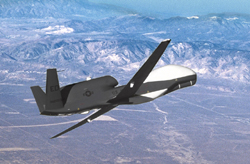
Right from the start, Global Hawk's performance has been "highly satisfactory," the general said. "On its first two missions, Global Hawk provided 'actionable intelligence' to support the warfighter mission."
Global Hawk's use in OEF has been an unqualified success, according to Col. Scott Coale, Global Hawk program director at the Aeronautical Systems Center's reconnaissance systems program office here.
"The Global Hawk weapon system has proven its worth as a high-altitude, long-endurance platform -- producing timely, accurate (intelligence, surveillance and reconnaissance) products for theater commanders," Coale said.
Before Sept. 11, 2001, the Global Hawk program office staff was fully focused on the UAV's acquisition and development. All that changed following the terrorist attacks.
"In less than 50 days, hundreds of government and contractor team members totally refocused this program," Coale said. "We took an immature system and fused it into a seamless, operational entity that could deliver time-critical targeting information to warfighters supporting OEF."
Despite the additional workload, the staff also continued to execute traditional development efforts for the UAV, even venturing into novel acquisition territory, according to the colonel.
"We're pioneering a new, evolutionary acquisition approach called 'spiral development' that will put initial Global Hawk capabilities into warfighters' hands sooner than more conventional acquisition methods," Coale said.
The current Global Hawk acquisition strategy calls for six development spirals and 10 production lots, the colonel said.
"We're now in Spiral 2, which will improve the air vehicle's structural and power systems in preparation for greater sensor capabilities delivered in future spirals," Coale said. "This includes an improved wing design and fuselage modifications to increase mission payload capacity to 3,000 pounds. Such changes will allow Global Hawk to meet future systems performance requirements for altitude, range and endurance.
"Spirals 3 and 4 will integrate additional capabilities, such the Multi-Platform Radar Technology Insertion Program and signals intelligence sensors, as well as provide improved communications functionality," Coale added. "Spirals 5 and 6 will incorporate more performance and reliability improvements and allow for future technology insertion opportunities."
Currently, Global Hawk can fly at more than 65,000 feet, travel 1,200 nautical miles to an operating area and remain there for more than 24 hours before returning to base.
To date, prime contractor Northrop Grumman Integrated Systems of San Diego has delivered six Global Hawks to the Air Force. The seventh and final advanced concept technology platform -- slated for use as a test vehicle to support development and upgrade efforts -- is scheduled for delivery later this month.
While the first production mission control element is scheduled for delivery by August, the first two production Global Hawks are respectively slated for delivery by September and December 2003, Coale said.
"These aircraft will incorporate initial performance improvements -- plus reliability, maintainability and supportability enhancements," Coale said. "They will use the existing integrated sensor suite (electro-optical, infrared and synthetic aperture radar sensors) to provide all-weather, day/night, high-resolution imaging capabilities."
Future production lots will add more payload capacity for a signals intelligence system and upgraded sensors, the colonel said. The final production Global Hawk is scheduled for delivery by 2013.
Missile Defense Test Conducted
The Missile Defense Agency (MDA) announced today it was not able to complete a test involving the planned intercept of a long-range ballistic missile target over the central Pacific Ocean when the exoatmospheric kill vehicle (EKV) interceptor and the booster rocket failed to separate, preventing the EKV from engaging the target warhead in space.
A modified Minuteman II intercontinental ballistic missile (ICBM) carrying the target warhead was successfully launched from Vandenberg Air Force Base, Calif., at 12:26 a.m. PST, and the booster rocket carrying the EKV was launched approximately 20 minutes later and about 4,800 miles away from Kwajalein Atoll in the Republic of the Marshall Islands. This test was conducted in support of research and development efforts for the Ground-based Midcourse Defense (GMD) program.
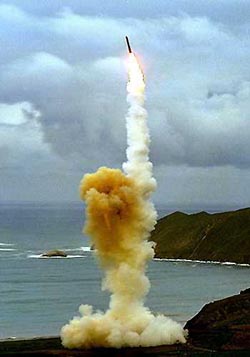
This was the final planned test involving the use of the interceptor's booster rocket that has been serving as a surrogate booster system and used for all GMD intercept tests since 1999. In a test on July 8, 2000, an apparently similar anomaly resulted in not completing the test due to the booster and EKV not separating. The surrogate booster is used for the developmental flight test program only, and is not intended for further use in the GMD test program or for a future operational GMD system. Two new booster designs are currently in development and will undergo flight testing beginning next spring. One or both of the new boosters will be used by the GMD program in all future intercept tests beginning late next year.
Initial post-test analysis indicate that all other GMD program elements successfully completed their test objectives, including radars and other sensors, as well as the battle management, command, control and communication elements that are vital in the GMD development effort. In a missile defense research and development program involving a number of different elements such as GMD, the successful integration of system elements is as important as the intercept. USS Lake Erie, an Aegis cruiser, successfully tracked the target missile after launch, and the Airborne Laser, a modified Boeing 747 aircraft, successfully used an installed infrared sensor to detect and track the boosting target missile after launch. The developmental Theater High Altitude Area Defense (THAAD) radar located at Vandenberg Air Force Base also performed well, successfully tracking the target missile after launch.
This was the eighth intercept test of the GMD research and development program. The first test on Oct. 3, 1999, resulted in the successful intercept of a ballistic missile target. The second test took place on Jan. 19, 2000, and did not achieve an intercept due to a clogged cooling pipe on the EKV, but did successfully test the integrated system of elements. The third test, on July 8, 2000, did not result in an intercept due an unsuccessful separation of the EKV and the booster rocket. The fourth test, on July 14, 2001, achieved a successful intercept of a ballistic missile target, as did tests on Dec. 3, 2001, and March 15, 2002. The successful test on Oct. 14, 2002 included the use of a ship-based SPY-1 radar for the first time to track a long-range target missile. The last four tests used all GMD system elements as part of an integrated flight test.
Government and industry program officials will conduct an extensive review of the test results to determine the reason(s) why EKV/booster separation did not occur, as well as a thorough analysis of all test-related data. Due to the vast amount of telemetry and other data collected during the test, it is likely to be at least several days until even a preliminary evaluation is completed.
Northrop Grumman Conducts Supersonic Flight Test of MALI
Northrop Grumman Corporation's Integrated Systems sector has successfully completed the first supersonic free flight of its Miniature Air-Launched Interceptor (MALI) at Naval Air Warfare Center, China Lake, Calif. All test objectives were met.
The Nov. 26 flight achieved a major milestone toward completing Northrop Grumman's advanced technology demonstration program for the Defense Advanced Research Projects Agency. MALI is being developed to demonstrate the ability to intercept incoming cruise missiles in air-to-air engagements.
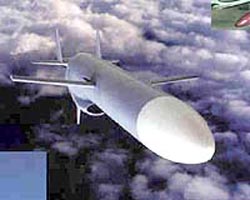
The vehicle was launched from an F-4 fighter at an altitude of 20,000 feet MSL. Following launch, it flew for 11.5 minutes in a racetrack pattern through nine waypoints. The vehicle reached air speeds of up to Mach 1.1, achieving the primary objective of supersonic flight. The test also achieved the following objectives: captive carry on the F-4 prior to launch; separation from the launch aircraft; vehicle engine start and transition to stable flight; normal operation of all flight critical sensors including the inertial measurement unit, GPS and air data system; proper fuel system operation; proper engine operation throughout the flight; and safe recovery from the designated area at the test range.
MALI is one of a family of miniature vehicle systems in development by Northrop Grumman. Another derivative in that family is a candidate for the Air Force's Miniature Air Launched Decoy (MALD) program. Deployed to achieve air superiority by confusing enemy air defense systems, MALD would operate autonomously to simulate the signature and mission profiles of aircraft such as the F-16, including the ability to maneuver and fly in formations. These unique capabilities would enable the decoy to deceive enemy air defenses without risk to pilots or aircraft.
[ Send Us News | Archives ]
by Gail Helmer
Wednesday December 11, 2002
- Delta Force: Land Warrior Patch v1.00.42
- Ultimate Gamers Expo Announced
- Codemasters Offers Career Guides
- USS Paul Hamilton Collides with Vessel in Arabian Gulf
- Air Force boss to Grill F/A-22 execs
- UAV Provide Warfighters A View
- Missile Defense Test Conducted
- Northrop Grumman Conducts Supersonic Flight Test of MALI
Delta Force: Land Warrior Patch v1.00.42
NovaLogic has issued new patches for Delta Force: Land Warrior, updating their older tactical first-person shooter to version 1.00.42. This is a "maintenance release incorporating fixes to various cheats". Download
Ultimate Gamers Expo Announced
A new gaming expo has been announced that is open to the public and not restricted by age, unlike the industries biggest gaming event of the year, E3 (Electronic Entertainment Expo). The new three-day show, the Ultimate Gamers Expo, will run from August 15 through 17, 2003, in the Los Angeles Convention Center's south hall.
The purpose of the UGE is to allow "gamers of all ages to test-drive the latest games and platforms, participate in tournaments, attend game design workshops, and enjoy live entertainment." The UGE is running at the same time as the X-Games, which will take place adjacent to the convention center. More details are available on the UGE Website
Codemasters Offers Career Guides
Codemasters is now offering a series of free career guides on its website, designed to help people maneuver through the first steps to a position in the game industry. Tips are currently offered on obtaining jobs in the graphics, programming and quality assurance (QA) fields. Codemasters launched the service in response to the "thousands" of letters and emails the company has received from students, who ask for advice on the courses they should take, and the qualifications needed, to break into the game business.
Military News
USS Paul Hamilton Collides with Vessel in Arabian Gulf
USS Paul Hamilton (DDG 60) collided with an unidentified vessel while conducting maritime operations in the North Arabian Gulf Dec. 6. No personnel were injured aboard Paul Hamilton. The ship suffered a hole in its side above the waterline but is still able to continue its mission. The cause of the incident is under investigation.

Paul Hamilton is part of the USS Abraham Lincoln (CVN 72) battle group, which is deployed for its regularly scheduled six-month deployment on station in support of Operation Enduring Freedom.
Paul Hamilton is an Arleigh Burke-class destroyer and is designed to help safeguard larger ships in the battle group. Its role is to primarily to perform strike, anti-air, anti-submarine and anti-surface warfare duty.
Air Force boss to Grill F/A-22 execs
Lockheed Martin managers are likely to face tough questions today from Air Force Secretary James Roche about continuing delays and new cost overruns in the F/A-22 fighter program.
The stealthy, supersonic jets being built in Marietta are the centerpiece of the Air Force's future strategy, and Roche has staked his career on getting the cutting-edge planes into the U.S. arsenal.
But Roche and other Bush administration and Pentagon officials were bitterly disappointed last month when they learned of a $690 million overrun in F/A-22 development costs.

They reacted by firing the top two Air Force generals in charge of the program and insisted Lockheed replace its top F/A-22 executive in Marietta. The turmoil ended two years of relative peace for the program, which narrowly survived a congressional revolt in 1999.
Today, Roche is coming to Marietta for face-to-face meetings with top Lockheed managers, and observers say the conversations probably won't be pleasant.
"Roche isn't happy, and Lockheed's senior managers are going to hear about it," said Loren Thompson, a defense analyst at the independent Lexington Institute. "He's gone to bat for Lockheed and the F/A-22 many times, and his reputation is riding on this program. He doesn't want any more surprises."
Richard Aboulafia, aerospace analyst at Teal Group, said the "chummy relationship" between Lockheed and the Air Force is over.
"The good old days of the Air Force rallying behind the contractor are over," he said. "The Pentagon is willing to use the C-word -- even though outright cancellation is an unlikely scenario."
Pentagon officials estimate the latest overrun could rise to $1 billion, and that could reduce the number of F/A-22s the Air Force ultimately gets. The Air Force originally sought 750 of the planes designed to replace the F-15C Eagle as the world's top fighter, but that number has been steadily cut to 339 and could fall further.
Congress has capped F/A-22 spending and barred the Air Force from paying for the planes with money from other programs. So far, the Pentagon has spent $26 billion, and about a dozen F/A-22s have been built for flight testing. The planes are scheduled to enter front-line squadrons in 2005 -- several years later than envisioned when the program was launched in the late 1980s.
"This visit is probably intended as a warning to Lockheed and the Air Force that future cost overruns aren't going to be tolerated," said Paul Nisbet, aerospace analyst at JSA Research.
"The hardest part of the program is yet to come. They've got to integrate all of these new components. And the Air Force wants the work done on schedule and on budget."
Pentagon officials have hinted in recent weeks that the F/A-22 program is in danger of being scrapped. Last week, Roche's top deputy termed the program "fragile."
But defense experts said cancellation is unlikely.
"They've sunk too much into the F/A-22 to walk away," Nisbet said. "They can't afford to start over."
Greg Caires, a spokesman at the Marietta plant, said the company expects "frank and candid discussions" today about "how to move the program forward."
UAV Provide Warfighters A View
For most of the past year, the Air Force's Global Hawk unmanned aerial vehicle has supported Operation Enduring Freedom by giving warfighters a precise view of the battle space.
Global Hawk has provided more than 15,000 intelligence, surveillance and reconnaissance images of potential enemy targets during 50 combat missions surpassing 1,000 flight hours.
"Global Hawk has been an imagery intelligence workhorse for OEF," said U.S. Army Brig. Gen. John F. Kimmons, director of intelligence for U.S. Central Command. "Its high-altitude and long endurance capabilities have been critical to CENTCOM operations.

Right from the start, Global Hawk's performance has been "highly satisfactory," the general said. "On its first two missions, Global Hawk provided 'actionable intelligence' to support the warfighter mission."
Global Hawk's use in OEF has been an unqualified success, according to Col. Scott Coale, Global Hawk program director at the Aeronautical Systems Center's reconnaissance systems program office here.
"The Global Hawk weapon system has proven its worth as a high-altitude, long-endurance platform -- producing timely, accurate (intelligence, surveillance and reconnaissance) products for theater commanders," Coale said.
Before Sept. 11, 2001, the Global Hawk program office staff was fully focused on the UAV's acquisition and development. All that changed following the terrorist attacks.
"In less than 50 days, hundreds of government and contractor team members totally refocused this program," Coale said. "We took an immature system and fused it into a seamless, operational entity that could deliver time-critical targeting information to warfighters supporting OEF."
Despite the additional workload, the staff also continued to execute traditional development efforts for the UAV, even venturing into novel acquisition territory, according to the colonel.
"We're pioneering a new, evolutionary acquisition approach called 'spiral development' that will put initial Global Hawk capabilities into warfighters' hands sooner than more conventional acquisition methods," Coale said.
The current Global Hawk acquisition strategy calls for six development spirals and 10 production lots, the colonel said.
"We're now in Spiral 2, which will improve the air vehicle's structural and power systems in preparation for greater sensor capabilities delivered in future spirals," Coale said. "This includes an improved wing design and fuselage modifications to increase mission payload capacity to 3,000 pounds. Such changes will allow Global Hawk to meet future systems performance requirements for altitude, range and endurance.
"Spirals 3 and 4 will integrate additional capabilities, such the Multi-Platform Radar Technology Insertion Program and signals intelligence sensors, as well as provide improved communications functionality," Coale added. "Spirals 5 and 6 will incorporate more performance and reliability improvements and allow for future technology insertion opportunities."
Currently, Global Hawk can fly at more than 65,000 feet, travel 1,200 nautical miles to an operating area and remain there for more than 24 hours before returning to base.
To date, prime contractor Northrop Grumman Integrated Systems of San Diego has delivered six Global Hawks to the Air Force. The seventh and final advanced concept technology platform -- slated for use as a test vehicle to support development and upgrade efforts -- is scheduled for delivery later this month.
While the first production mission control element is scheduled for delivery by August, the first two production Global Hawks are respectively slated for delivery by September and December 2003, Coale said.
"These aircraft will incorporate initial performance improvements -- plus reliability, maintainability and supportability enhancements," Coale said. "They will use the existing integrated sensor suite (electro-optical, infrared and synthetic aperture radar sensors) to provide all-weather, day/night, high-resolution imaging capabilities."
Future production lots will add more payload capacity for a signals intelligence system and upgraded sensors, the colonel said. The final production Global Hawk is scheduled for delivery by 2013.
Missile Defense Test Conducted
The Missile Defense Agency (MDA) announced today it was not able to complete a test involving the planned intercept of a long-range ballistic missile target over the central Pacific Ocean when the exoatmospheric kill vehicle (EKV) interceptor and the booster rocket failed to separate, preventing the EKV from engaging the target warhead in space.
A modified Minuteman II intercontinental ballistic missile (ICBM) carrying the target warhead was successfully launched from Vandenberg Air Force Base, Calif., at 12:26 a.m. PST, and the booster rocket carrying the EKV was launched approximately 20 minutes later and about 4,800 miles away from Kwajalein Atoll in the Republic of the Marshall Islands. This test was conducted in support of research and development efforts for the Ground-based Midcourse Defense (GMD) program.

This was the final planned test involving the use of the interceptor's booster rocket that has been serving as a surrogate booster system and used for all GMD intercept tests since 1999. In a test on July 8, 2000, an apparently similar anomaly resulted in not completing the test due to the booster and EKV not separating. The surrogate booster is used for the developmental flight test program only, and is not intended for further use in the GMD test program or for a future operational GMD system. Two new booster designs are currently in development and will undergo flight testing beginning next spring. One or both of the new boosters will be used by the GMD program in all future intercept tests beginning late next year.
Initial post-test analysis indicate that all other GMD program elements successfully completed their test objectives, including radars and other sensors, as well as the battle management, command, control and communication elements that are vital in the GMD development effort. In a missile defense research and development program involving a number of different elements such as GMD, the successful integration of system elements is as important as the intercept. USS Lake Erie, an Aegis cruiser, successfully tracked the target missile after launch, and the Airborne Laser, a modified Boeing 747 aircraft, successfully used an installed infrared sensor to detect and track the boosting target missile after launch. The developmental Theater High Altitude Area Defense (THAAD) radar located at Vandenberg Air Force Base also performed well, successfully tracking the target missile after launch.
This was the eighth intercept test of the GMD research and development program. The first test on Oct. 3, 1999, resulted in the successful intercept of a ballistic missile target. The second test took place on Jan. 19, 2000, and did not achieve an intercept due to a clogged cooling pipe on the EKV, but did successfully test the integrated system of elements. The third test, on July 8, 2000, did not result in an intercept due an unsuccessful separation of the EKV and the booster rocket. The fourth test, on July 14, 2001, achieved a successful intercept of a ballistic missile target, as did tests on Dec. 3, 2001, and March 15, 2002. The successful test on Oct. 14, 2002 included the use of a ship-based SPY-1 radar for the first time to track a long-range target missile. The last four tests used all GMD system elements as part of an integrated flight test.
Government and industry program officials will conduct an extensive review of the test results to determine the reason(s) why EKV/booster separation did not occur, as well as a thorough analysis of all test-related data. Due to the vast amount of telemetry and other data collected during the test, it is likely to be at least several days until even a preliminary evaluation is completed.
Northrop Grumman Conducts Supersonic Flight Test of MALI
Northrop Grumman Corporation's Integrated Systems sector has successfully completed the first supersonic free flight of its Miniature Air-Launched Interceptor (MALI) at Naval Air Warfare Center, China Lake, Calif. All test objectives were met.
The Nov. 26 flight achieved a major milestone toward completing Northrop Grumman's advanced technology demonstration program for the Defense Advanced Research Projects Agency. MALI is being developed to demonstrate the ability to intercept incoming cruise missiles in air-to-air engagements.

The vehicle was launched from an F-4 fighter at an altitude of 20,000 feet MSL. Following launch, it flew for 11.5 minutes in a racetrack pattern through nine waypoints. The vehicle reached air speeds of up to Mach 1.1, achieving the primary objective of supersonic flight. The test also achieved the following objectives: captive carry on the F-4 prior to launch; separation from the launch aircraft; vehicle engine start and transition to stable flight; normal operation of all flight critical sensors including the inertial measurement unit, GPS and air data system; proper fuel system operation; proper engine operation throughout the flight; and safe recovery from the designated area at the test range.
MALI is one of a family of miniature vehicle systems in development by Northrop Grumman. Another derivative in that family is a candidate for the Air Force's Miniature Air Launched Decoy (MALD) program. Deployed to achieve air superiority by confusing enemy air defense systems, MALD would operate autonomously to simulate the signature and mission profiles of aircraft such as the F-16, including the ability to maneuver and fly in formations. These unique capabilities would enable the decoy to deceive enemy air defenses without risk to pilots or aircraft.
